
The Butterfly Effect 🦋of Adaptability & Resilience Skills
10 min
January 06, 2023 · 10 min

When we talk to employers about remote work, one of the main benefits they cite is a reduction in costs. The savings can indeed be impressive at first sight. You can stop maintaining the fancy office buildings and parking lots. You can save on heating, lighting, security, and if you are a tech company, the obligatory free Mountain Dew. In fact, the cost reductions are so significant for some employers that they’ve told us they would like to return to the office but just cannot justify the move financially.
But, once you consider all factors, is remote work REALLY cheaper? The short answer is probably yes, but if you implement remote work properly, the savings may not be as significant as you might expect. As you find out how to really make remote work work you will spend less on some things and more on others. Here’s how it breaks down:
You can save significant money on maintaining buildings, alongside heating, lighting, and security. Where possible you can sell buildings or terminate leases. Many organizations are doing exactly that, which in some markets is creating a significant surplus of office space and corresponding downward pressure on the market overall.
WeWork may be a damaged brand, but co-working spaces are here to stay, and they aren’t just for individuals and startups. Businesses of any size can benefit from the flexibility of these environments, flexing up and down as business conditions change. Co-working spaces can provide many of the benefits of a regular office, with the added benefit of allowing your employees to dramatically reduce their commute times. Through co-working spaces, you are moving the office to your people.
Employees are becoming increasingly attracted to co-working spaces for a number of reasons. They can combat feelings of loneliness and disconnectedness. Co-working spaces are often seen as more vibrant than traditional office settings. And spontaneous interactions can happen not just within companies but between them. We’ve seen multiple examples of partnerships that have emerged from co-working environments.
If you are going to spend money on co-working spaces, consider creating an arrangement with a national network of them. Remote workers can be located anywhere, and remote workspaces are also hugely helpful when your employees are traveling.
The stationery room has way less in it than it used to. But with no people in your building, you don’t need them at all. The same applies to desks, chairs, monitors, phones – pretty much anything in the standard employee toolkit.
But of course employees still need those things, and because they are not in a standardized workspace anymore precisely what they need will vary. Great remote-first employers typically provide a suggested remote work toolkit for employees, either offering it through an online store or reimbursing employees for it. B2BReviews offers key recommendations for what should be in a remote work toolkit here.
The toolkit will continue to evolve of course. Over the next few years, there will also be a dramatic improvement in capabilities offered through Video Conferencing, Virtual Assistants and the Metaverse. Collectively these will serve to create a much richer remote work experience that overcomes many of the challenges remote workers face today. To access these services your employees will need new hardware and software that is available to them wherever they are.
Until recently, face-to-face was really the only effective way to get a lot of business done. The pandemic forced that to change, and as we have exited those restrictions, many companies have continued to see a reduction in business travel. Going forward, video conferencing and metaverse investments will increase further the amount of business that you can do remotely.
Gathering together is a natural human instinct and can lead to closer relationships and spontaneous interactions that are very difficult to replicate in the virtual world. Organizations that excel at remote work usually gather employees physically together regularly – often as commonly as once per quarter. These gatherings typically have three complementary goals – to strengthen ties between employees, to increase the connection between employee and employer, and to drive innovation through a different work style. They are ostensibly a reimagination of the company offsite – one that reflects the new needs of the remote workforce. As your workforce becomes increasingly distributed, most employees will need to travel to wherever you gather.
Your organization may devolve this to the team level, do it at the company level, or do a combination of the two, but spending money on this helps ensure that remote work does not make employees remote from each other and their company.
What is the point of a centralized data center when your employees are not located anywhere near it? The same applies to physical infrastructure – printers, physical meeting rooms – even cafeterias.
As employees become distributed, it makes more sense for the infrastructure that supports them to also be distributed – largely on demand. Your adoption of cloud-based services will increase, and physical infrastructure will be accessed through arrangements with co-working spaces and providers such as FedEx. There will be an ever-increasing need for high bandwidth connections to wherever your employees are located.
For companies with one or a small number of offices, it often makes sense to provide employee assistance services locally, either physically in the office, or with specialists local to the office that understand the local conditions. However, once employees are distributed nationally or internationally, the benefit of this kind of service diminishes.
Once your employees are everywhere, the challenges they face become more diverse, and reflect as much where they live as where they work. Not only that but as more employees work out of the office, the uptake of Employee Assistance Programs is increasing. Some of this appears to be related to the challenges of remote work itself, with employees finding it difficult to separate work from life and a corresponding deterioration of relationships.
If you do not have a formalized EAP, now is likely the time to consider one with national coverage that includes effective mental health support, relationship, and financial counseling.
Guest speakers can be awesome, and for all the dud one-day training sessions you’ve had, it’s likely you’ve been in one or two that have stayed with you. However, in a remote-first environment, the impact of these types of sessions is often severely diminished. Technology has not advanced sufficiently for trainers and speakers to create a meaningful immersive connection with their audience. So in general you will likely reduce the number of these, focusing on high-impact sessions that are delivered when your employees gather physically.
Distance learning has advanced dramatically in the last decade, and with it, our understanding of how it can meet the needs of neurodiverse students and employees. As individuals, we learn best at different times of day, in different ways, and at different paces. Fortunately, well-structured self-paced learning environments can accommodate all of this, and lead to better results overall.
In addition to investing in self-paced learning and development generally, consider that your employees need SPECIFIC training on how to excel at working outside of a formal office. And this should not just be theory – it needs to translate to behaviors that create motivated, productive remote employees and a high trust relationship between employees, their colleagues, and their managers. BillionMinds offers exactly this – you can find out more here.
Once you are a remote-first organization, you can hire from anywhere. As your pool of available talent increases exponentially, you will be able to optimize some roles based on cost, for example by paying employees less if they live in certain areas. In other cases, roles that needed to be full-time will be able to transfer to hourly, which may reduce both salary and benefits costs to your organization.
Employers will only be able to pay employees less from certain regions for so long. In fact, some employers are already paying people the same regardless of where they live, which is starting to create competitive pressures in the war for talent. Over time, technology will make it even easier for employees to find higher-paying employees, which will level the playing field further. As these shifts happen, employers may well pay MORE for top talent that aligns with their most strategic objectives, but do so in the confidence that they have been able to source talent that will yield the best business results.
Remote work environments will radically change how work is done, and create HUGE business opportunities for organizations ready to take advantage of it. There certainly are cost benefits to be had by switching to remote, but in the medium term, by far the greater benefits will come from the talents of a remote workforce armed with the skills, technology, and support they need to do their best work. Organizations that seize this opportunity now can position themselves with a major competitive advantage.